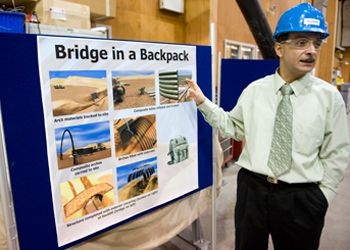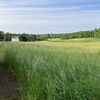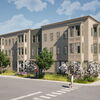Processing Your Payment
Please do not leave this page until complete. This can take a few moments.
- News
-
Editions
View Digital Editions
Biweekly Issues
- December 1, 2025
- Nov. 17, 2025
- November 03, 2025
- October 20, 2025
- October 6, 2025
- September 22, 2025
- + More
Special Editions
- Lists
- Viewpoints
-
Our Events
Event Info
Award Honorees
- Calendar
- Biz Marketplace
Composites spawn two new ventures
 Photo/Brandon McKenney
Spin-offs: Habib Dagher, director of UMaine's Advanced Engineered Wood Composites Center, says the lab has moved from research to commercialization of products, bringing it "world-class status."
Photo/Brandon McKenney
Spin-offs: Habib Dagher, director of UMaine's Advanced Engineered Wood Composites Center, says the lab has moved from research to commercialization of products, bringing it "world-class status."
One is up. One is under way.
But both of the bridges constructed with ground-breaking composites developed in Maine have produced something as tangible as their 50-foot spans: new businesses.
The first bridge using new composite techniques developed by the University of Maine’s Advanced Engineered Wood Composites Center in Orono is the Neal Bridge in Pittsfield, which connects routes 100 and 11. The span was built by Advanced Infrastructure Technologies, a direct spin-off of the composite center, which holds the license for a new type of composite component that it expects to manufacture commercially within a matter of months.
The other bridge, using a separate but related technology patented by a Chicago inventor, will connect an island in Boothbay Harbor to the mainland via a 500-foot span when construction begins this summer. Like the Pittsfield span, the Boothbay bridge is considered a demonstration project. Harbor
Technologies, which will build the Boothbay bridge, has been licensed exclusively for seven years to produce the span, which was selected by Popular Science as one of the top 10 inventions of 2008.
The market for these bridges could be big — “gargantuan” says Martin Grimnes, president of Harbor Technologies in Brunswick. At an unveiling ceremony last month for the composite modules, Gov. John Baldacci announced that the Maine Department of Transportation will build six more composite bridges in its 2010-11 construction cycle, at a cost of $6 million. U.S. Rep. Michael Michaud, who serves on the House Transportation Committee, said he will press the committee to specify composite spans in the six-year transportation reauthorization bill that’s expected to get to the House floor in June.
The ceremony marked not just the public introduction of the composite modules, but their graduation from the classroom to the business world.
Habib Dagher, director of AEWC, says the center has gone from research and development into licensing some of its top bridge designs, garnering it “world-class status.”
At the heart of that growing interest is what’s been dubbed “a bridge in a backpack.” A combination of inflatable molds, concrete and high-tech composites produce variable-length spans that are stronger and more durable than reinforced concrete, yet weigh only one-eighth as much.
The new bridges present clear advantages over existing concrete and steel spans, says Dagher, and were brought to market at equivalent costs. The composites are expected to last two to three times longer than conventional bridges, will require substantially less maintenance and won’t corrode, eliminating a significant source of environmental contamination, says Dagher.
Grimnes says the advantages of composites extend from manufacturing to transporting the spans to the bridge site. The 50-foot spans Harbor Technologies is building weigh 8,000 pounds instead of the 63,000 pounds of a similar steel-reinforced concrete structure.
The secret lies in the composite tubes that surround the concrete and steel components, marrying concrete’s resistance to compression with steel’s tensile strength.
The components in the Pittsfield bridge, which AIT will begin manufacturing in a 48,000-square-foot-structure in Orono adjacent to the composites lab, are even simpler. They start with flexible composite tubes that can take virtually any shape, and are then filled with concrete – no steel – and harden overnight.
Dagher supplied the know-how for the AIT bridge, which was financed by the center. To commercialize the technology, several investors will contribute the capital, led by Brit Svoboda, a Bangor native who recently returned to the area.
Svoboda was originally inquiring into commercialization possibilities for the AEWC off-shore wind towers, said Dagher, but was so impressed by the composite bridges that he decided to start a company to build them right away.
The “bridge in a backpack” — referring to the flexible tubing — could revolutionize concrete bridge construction, which now takes months, with enormous quantities of plywood forms and many concrete pours. Small spans, Dagher says, could be built in a weekend.
One irony of the two composite bridge techniques is that they contain no wood – despite the “Wood” in the AEWC name and the original focus of bridge designs at the lab. But what they lack in Maine-made materials, they more than make up for in Maine know-how and manufacturing capacity.
Harbor Technologies expects to more than double its existing work force of 20 to 40 or 50, while AIT expects to have 100 employees within five years, Dagher says.
The growth of AEWC has been equally strong. It now has 140 employees, including many top scientists and engineers. Originally launched with grants from the University of Maine and buttressed with state bond issues, AEWC is now almost entirely financed by contracts with commercial clients. “Only 3% of our funding comes from the university now,” Dagher says, though he declined to specify the lab’s annual budget. “We’re really a business in our own right, even if we’re still located on campus.”
Despite the seemingly sudden rollout of what was once called “space age” technology, these designs have been in the works for some time. The basic concept was hatched six years ago at AEWC, and it takes a long time to bring such ideas to commercial reality, Dagher says. “None of this takes place overnight. It takes a lot of diligence and hard work to bring these techniques to market.”
But with the federal stimulus bill now law, and a major transportation bill on the horizon, the timing seems perfect.
Grimnes said a federal study showed that unmet transportation infrastructure needs in 2007 totaled $1.6 trillion, and that the annual cost of corrosion in all components (including vehicles) amounts to $300 billion. “Once we get rolling, I don’t think there will be any lack of business,” he says.
Mainebiz web partners

The Giving Guide
The Giving Guide helps nonprofits have the opportunity to showcase and differentiate their organizations so that businesses better understand how they can contribute to a nonprofit’s mission and work.
Learn More
Work for ME
Work for ME is a workforce development tool to help Maine’s employers target Maine’s emerging workforce. Work for ME highlights each industry, its impact on Maine’s economy, the jobs available to entry-level workers, the training and education needed to get a career started.
Learn More
Groundbreaking Maine
Whether you’re a developer, financer, architect, or industry enthusiast, Groundbreaking Maine is crafted to be your go-to source for valuable insights in Maine’s real estate and construction community.
Learn more-
The Giving Guide
The Giving Guide helps nonprofits have the opportunity to showcase and differentiate their organizations so that businesses better understand how they can contribute to a nonprofit’s mission and work.
-
Work for ME
Work for ME is a workforce development tool to help Maine’s employers target Maine’s emerging workforce. Work for ME highlights each industry, its impact on Maine’s economy, the jobs available to entry-level workers, the training and education needed to get a career started.
-
Groundbreaking Maine
Whether you’re a developer, financer, architect, or industry enthusiast, Groundbreaking Maine is crafted to be your go-to source for valuable insights in Maine’s real estate and construction community.
ABOUT
NEW ENGLAND BUSINESS MEDIA SITES
No articles left
Get access now
In order to use this feature, we need some information from you. You can also login or register for a free account.
By clicking submit you are agreeing to our cookie usage and Privacy Policy
Already have an account? Login
Already have an account? Login
Want to create an account? Register
Get access now
In order to use this feature, we need some information from you. You can also login or register for a free account.
By clicking submit you are agreeing to our cookie usage and Privacy Policy
Already have an account? Login
Already have an account? Login
Want to create an account? Register







Comments